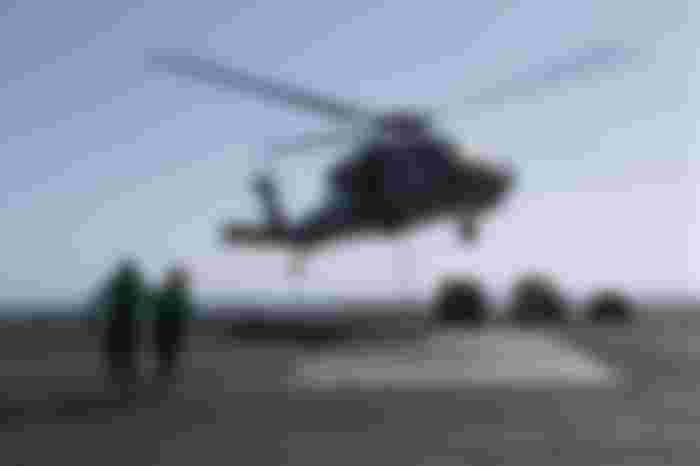
US-imposed sanctions have tanked Iran’s economy, and Tehran desperately wants them lifted. But with few options to compel the Trump administration to change course, Iranian leaders may choose a more violent tactic to make their point, especially after Soleimani’s death.
Iranian forces could bomb an American oil tanker traveling through the Strait of Hormuz, a vital waterway for the global energy trade aggressively patrolled by Tehran’s forces, causing loss of life or a catastrophic oil spill. The country’s skillful hackers could launch a major cyberattack on regional allies like Saudi Arabia or the United Arab Emirates.
Israel could kill an Iranian nuclear scientist, leading Iran to strike back and drawing the US into the spat, especially if Tehran responds forcefully. Or Iranian-linked proxies could target and murder American troops and diplomats in Iraq.
That last option is particularly likely, experts say. After all, Iran bombed US Marine barracks in Lebanon in 1983 and killed more than 600 US troops during the Iraq War. Taking this step may seem extreme, but “Iran could convince itself that it could do this,” Goldenberg, now at the Center for a New American Security think tank in Washington, told me.
At that point, it’d be nearly impossible for the Trump administration not to respond in kind. The recommendations given to the president would correspond to whatever action Iran took.
If Tehran destroyed an oil tanker, killing people and causing an oil spill, the US might destroy some of Iran’s ships. If Iran took out another US military drone, the US might take out some of Iran’s air defenses. And if Iranian-backed militants killed Americans in Iraq, then US troops stationed there could retaliate, killing militia fighters and targeting their bases of operation in return. The US could even bomb certain training grounds inside Iran or kill high-level officials.
It’s at this point that both sides would need to communicate their red lines to each other and how not to cross them. The problem is there are no direct channels between the two countries and they don’t particularly trust each other. So the situation could easily spiral out of control.
Messaging “is often more important than physical action,” Jasmine El-Gamal, formerly a Middle East adviser at the Pentagon, told me. “Action without corresponding messaging, public or private, could most certainly lead to escalation because the other side is free to interpret the action as they wish.”
Which means the initial tit-for-tat would serve as the precursor to much more bloodshed.
“What are we going to be wrong about?”
You may have heard the phrase “the fog of war.” It refers to how hard it is for opposing sides to know what’s going on in the heat of battle. It’s particularly difficult when they don’t talk to one another, as is the case with the US and Iran.
Which means that the way the US and Iran interpret each other’s next moves would mainly come down to guesswork.
Eric Brewer, who spent years in the intelligence community before joining Trump’s National Security Council to work on Iran, told me that’s when the Pentagon and other parts of the government rely heavily on their best-laid plans.
The problem, he noted, is that wars rarely play out as even the smartest officials think they will. A guiding question for him, then, is “what are we going to be wrong about?”
Here’s one scenario in which the US might get something wrong — and open up the door to chaos: After America launches its first set of retaliatory strikes, Iran decides to scatter its missiles to different parts of the country.
Now the Trump administration has to figure out why Iran did that. Some people in the administration might think it’s because Tehran plans to attack US embassies, troops, or allies in the region and is moving its missiles into position to do so. Others might believe that it was merely for defensive reasons, with Iran essentially trying to protect its missile arsenal from being taken out by future US strikes.
Without a clear answer, which interpretation wins out comes down to which camp in the Trump administration is the most persuasive. And if the camp that believes Iran is about to launch missile strikes wins, they could convince the president to take preemptive action against Iran.
That could be a good thing if they were right; after all, they’d have made sure Iran couldn’t carry out those planned attacks. But what if they were wrong? What if the other camp guessed correctly that Iran was merely moving its missiles around because it was scared the US would strike once more? In that case, the US would have bombed Iran again, this time for essentially no reason — thus looking like the aggressor.
That could cause Iran to retaliate with a bigger attack, setting off a spiral that could end in full-scale war.
Iran could make a grave error too. Imagine Trump sends thousands of troops, say 25,000, along with advanced warplanesto the Middle East in the hope that they’ll deter Iran from escalating the conflict any further.
Tehran could just as easily read that buildup as preparation for a US invasion. If that’s the case, Iranian forces could choose to strike first in an effort to complicate the perceived incursion.
Of course, cooler heads could prevail in those moments. But experts say the political pressures on both Washington and Tehran not to be attacked first — and not to be embarrassed or look weak — might be too strong for the countries’ leaders to ignore.
“Unintended civilian casualties or other collateral damage is always possible, and it is not clear that this administration — or any administration — understands what Iran’s own red lines are,” El-Gamal, now at the Atlantic Council think tank in Washington, told me. “As such, the greatest risk of a full-blown war comes from one side miscalculating the other’s tolerance” for conflict.
If that proves true, and the US and Iran officially escalate their fighting to more than a few one-off attacks, it’s war.
